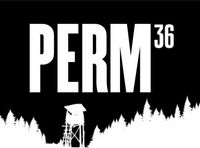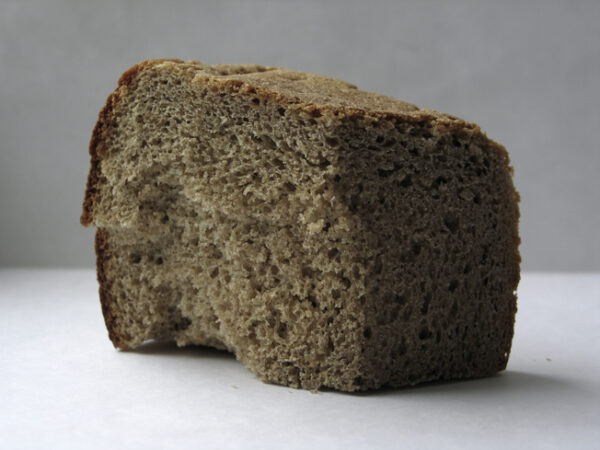The life of prisoners in political camps was organized according to the corrective labor codes, standard rules of internal order and decrees of the USSR Interior Ministry. The daily routine for the Perm-36 camp stipulated eight hours of sleep, eight hours of work with a two-hour break for meals – these two hours included searching prisoners as they were moved from the work zone to the living zone and back, two hours for assembly for work and dismissal from work, again with a long search in moving from one zone to another, and two hours for political lessons and compulsory unpaid work to tidy and “improve” the territory.
Photo: renovated search building for transfer from the living zone to the work zone, during which all prisoners were searched at each transfer, four times each day. One search of a group of 80-100 prisoners took up to one hour: they were searched thoroughly, in groups of five; sometimes they had to take their clothes off and had the seams of their clothing checked, while the rest of the prisoners stood in formation in front of the building or behind it, no matter what the weather was like.
The secret decree of the USSR Interior Ministry of 14 January 1972 established additional restrictions for highly dangerous state criminals: all movements of prisoners, apart from the morning toilet and an hour of “private” time in the evening, were only allowed in groups, even at a distance of several dozen meters from the barracks to the canteen. Prisoners were prohibited from entering the rooms of other groups, were prohibited to wear beards, and the names of the prisoners and the numbers of their groups were printed on labels sewn to their clothing. Prisoners were obliged to remove their hats in front of camp administration employees.
The list of products permitted in packages and parcels was limited, and also the assortment of products and goods at the camp shop, censorships rules for correspondence were toughened, and the periods that prisoners were held in punishment isolation cells were increased.

When employees of the law-enforcement bodies sentenced on criminal charges were held in this camp, toilets were installed in the barracks
The daily norms for nutrition for prisoners were determined by a decree of the USSR Interior Ministry of 16 August 1958. The changes made to it later were insignificant.
| Bread of rye flour | 700 g | Combined fat | 4 g |
| Wheat flour of the 2nd sort | 20 g | Sugar | 15 g |
| Various grains | 110g | Salt | 20 g |
| Pasta | 10 g | Tomato paste | 5g |
| Meat | 50 g | Bay leaf | 0.1g |
| Vegetable oil | 15 g | Vegetables | 250 g |
This ration was the minimum sufficient to maintain vital activity: in political camps, apart from prisoners held in punishment isolation cells, the prisoners did not starve, unlike in the general prison camps, where groceries were often stolen. But they were constantly hungry.
“You couldn’t say that the hunger was particularly painful – it wasn’t severe hunger, but slow, chronic underfeeding. So you soon stopped feeling it very strongly, you just felt a monotonous pain, like a toothache. You even stopped realizing that it was hunger, and after a few months, you suddenly noticed that you found it painful and uncomfortable to sit on a bench, and at night, you felt something squeezing and pressing you – you shook the mattress a few times, and you turned from side to side, you felt uncomfortable. You feel as though your bones were sticking out of you. But you didn’t really care anymore. And you couldn’t get up abruptly from the bunk – your head would start spinning.”
Vladimir Bukovsky “And the wind returns…”
Constant annoyances were the tasteless food, the monotony of the ration and the lack of fresh vegetables – fermented, sour cabbage and dried potatoes was almost always used. Even in autumn. Prisoners tried to diversify the ration with wild grass growing in the camp territory, which often caused stomach upsets and poisoning, and some tried to grow edible herbs, but these plants were mercilessly stomped on. The food sometimes contained worms…
Another severe problem was the cold. In the winter the temperature in the barracks and workshop hardly ever rose above the level of 18 degrees, which was stipulated by the rules for internal order.
The entire life of the prisoners took place within the camp perimeter – they were never taken outside the camp fences. They were transported from camp to camp in closed vehicles – avtozaks. There was not enough color – everything around them was gray. The prisoner Lev Timofeev found a solution – he asked for colorful stamps to be placed on the letters sent to him. When the administration employees realized this, they started cutting the stamps off the envelopes.
“…Or you receive a colorful postcard from home and you keep staring at it like an idiot, it’s so amazing to see different unfamiliar colors than you can’t take your eyes off it.”
Vladimir Bukovsky “And the wind returns…”




